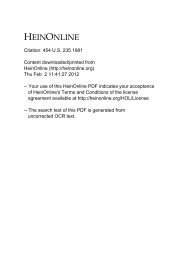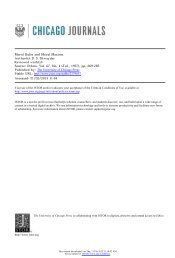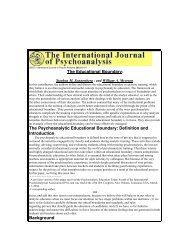Coagulation Factors in Controlling Traumatic Bleeds: FFP, PCC, or ...
Coagulation Factors in Controlling Traumatic Bleeds: FFP, PCC, or ...
Coagulation Factors in Controlling Traumatic Bleeds: FFP, PCC, or ...
Create successful ePaper yourself
Turn your PDF publications into a flip-book with our unique Google optimized e-Paper software.
e. Maj<strong>or</strong> drawback: risk of thrombotic complications 15,30,32,33<br />
i. Hemophilia B: deep ve<strong>in</strong> thrombosis, DIC, pulmonary embolisms, and acute myocardial <strong>in</strong>farctions<br />
rep<strong>or</strong>ted (1960s-80s) 33<br />
1. Supra-physiological levels of other fact<strong>or</strong>s (besides IX) <strong>in</strong> the preparation<br />
2. Repetitive dos<strong>in</strong>g<br />
ii. Cause may be due to activated fact<strong>or</strong> IX <strong>or</strong> presence of procoagulant phospholipids 33<br />
1. Reduction <strong>in</strong> thromboembolic complications among hemophilia B patients when highlypurified<br />
fact<strong>or</strong> IX began to replace <strong>PCC</strong>s – despite higher levels of fact<strong>or</strong> IX compared with <strong>PCC</strong><br />
2. Prothromb<strong>in</strong> cited to be maj<strong>or</strong> determ<strong>in</strong>ant of excessive thromb<strong>in</strong> generation <strong>in</strong> <strong>PCC</strong><br />
iii. Inclusion of coagulation <strong>in</strong>hibit<strong>or</strong>s – hepar<strong>in</strong>, antithromb<strong>in</strong>, prote<strong>in</strong> C, S, Z – may provide “balance”<br />
to coagulation fact<strong>or</strong>s, avoid<strong>in</strong>g excessive <strong>in</strong>crease <strong>in</strong> thromb<strong>in</strong> generation and reduc<strong>in</strong>g<br />
thrombotic risk 33<br />
iv. Incidence unknown – varies based on <strong>PCC</strong> content, dosage, concurrent use of procoagulants, and<br />
patient-specific risk fact<strong>or</strong>s (age, liver disease, surgery, hist<strong>or</strong>y of thrombosis)<br />
v. No evidence to suggest difference <strong>in</strong> thromboembolic risk between 3- and 4-fact<strong>or</strong> <strong>PCC</strong>s 33<br />
Dickneite G, et al. Prothromb<strong>in</strong> complex concentrate vs. fresh frozen plasma f<strong>or</strong> reversal of dilutional<br />
coagulopathy <strong>in</strong> a p<strong>or</strong>c<strong>in</strong>e trauma model. 2009. 34<br />
Design<br />
Randomized, placebo-controlled trial <strong>in</strong> pigs<br />
Population<br />
47 anaesthetized, mildly hypothermic (36°C) pigs<br />
Interventions<br />
65-70% of total blood volume substituted <strong>in</strong> phases with hydroxyethyl starch and pRBCs<br />
Randomized to receive: 15 mL/kg isotonic sal<strong>in</strong>e, 25 units/kg <strong>PCC</strong>, <strong>or</strong> standard-dose (15<br />
mL/kg) <strong>or</strong> high-dose (40 mL/kg) p<strong>or</strong>c<strong>in</strong>e <strong>FFP</strong><br />
4-fact<strong>or</strong> <strong>PCC</strong> used<br />
Immediately after treatment given, standardized <strong>in</strong>jury <strong>in</strong>flicted<br />
Endpo<strong>in</strong>ts<br />
PT, thromb<strong>in</strong> generation, time to hemostasis, volume of blood loss<br />
Results<br />
<strong>PCC</strong> therapy fully reversed prolonged PT and c<strong>or</strong>rected reduced peak thromb<strong>in</strong> generation<br />
Compared with 15 mL/kg <strong>FFP</strong>, <strong>PCC</strong> sh<strong>or</strong>ted time to hemostasis after either bone <strong>or</strong> spleen<br />
trauma, and reduced volume of blood loss<br />
Take Home Po<strong>in</strong>ts <strong>PCC</strong> 25 units/kg effective <strong>in</strong> c<strong>or</strong>rect<strong>in</strong>g dilutional coagulopathy and controll<strong>in</strong>g bleed<strong>in</strong>g when<br />
adm<strong>in</strong>istered pri<strong>or</strong> to trauma<br />
Grottke O, et al. Increas<strong>in</strong>g concentrations of prothromb<strong>in</strong> complex concentrate <strong>in</strong>duce dissem<strong>in</strong>ated<br />
<strong>in</strong>travascular coagulation <strong>in</strong> a pig model of coagulopathy with blunt liver <strong>in</strong>jury. 2011. 30<br />
Design<br />
Randomized, placebo-controlled trial <strong>in</strong> pigs<br />
Population<br />
27 anaesthetized pigs<br />
Interventions<br />
Coagulopathy <strong>in</strong>duced by replac<strong>in</strong>g ~70% blood volume with hydroxyethyl starch and<br />
R<strong>in</strong>ger’s lactate solution<br />
RBCs collected and re-transfused<br />
10 m<strong>in</strong> after trauma, animals randomly received 4-fact<strong>or</strong> <strong>PCC</strong> (35 <strong>or</strong> 50 units/kg) <strong>or</strong> sal<strong>in</strong>e<br />
Endpo<strong>in</strong>ts<br />
Blood loss; survival; presence of emboli<br />
Results<br />
Total blood loss significantly lower and survival higher <strong>in</strong> low- and high-dose <strong>PCC</strong> groups vs.<br />
sal<strong>in</strong>e group (p

















